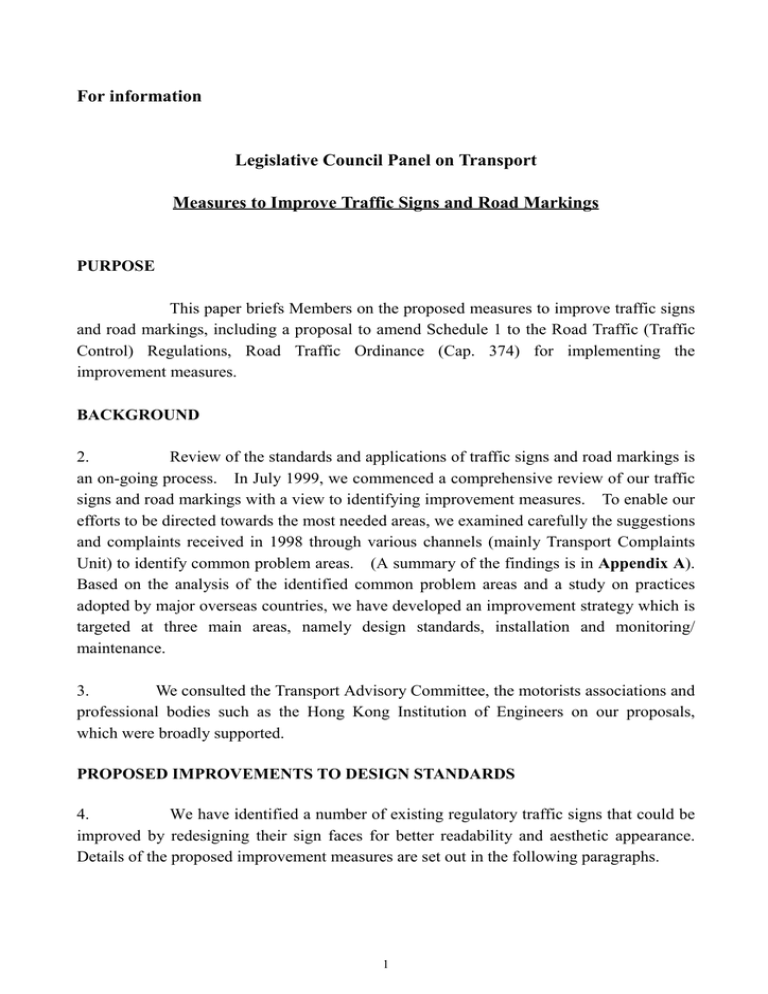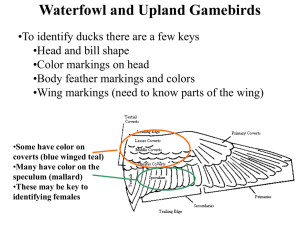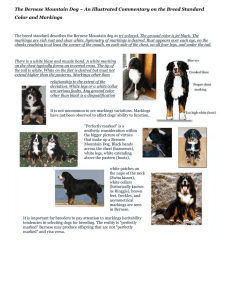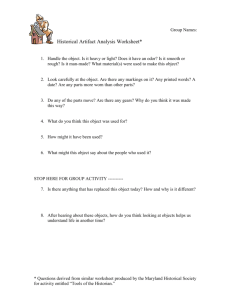CB(1)
advertisement

For information Legislative Council Panel on Transport Measures to Improve Traffic Signs and Road Markings PURPOSE This paper briefs Members on the proposed measures to improve traffic signs and road markings, including a proposal to amend Schedule 1 to the Road Traffic (Traffic Control) Regulations, Road Traffic Ordinance (Cap. 374) for implementing the improvement measures. BACKGROUND 2. Review of the standards and applications of traffic signs and road markings is an on-going process. In July 1999, we commenced a comprehensive review of our traffic signs and road markings with a view to identifying improvement measures. To enable our efforts to be directed towards the most needed areas, we examined carefully the suggestions and complaints received in 1998 through various channels (mainly Transport Complaints Unit) to identify common problem areas. (A summary of the findings is in Appendix A). Based on the analysis of the identified common problem areas and a study on practices adopted by major overseas countries, we have developed an improvement strategy which is targeted at three main areas, namely design standards, installation and monitoring/ maintenance. 3. We consulted the Transport Advisory Committee, the motorists associations and professional bodies such as the Hong Kong Institution of Engineers on our proposals, which were broadly supported. PROPOSED IMPROVEMENTS TO DESIGN STANDARDS 4. We have identified a number of existing regulatory traffic signs that could be improved by redesigning their sign faces for better readability and aesthetic appearance. Details of the proposed improvement measures are set out in the following paragraphs. 1 Traffic Signs and Road Markings 5. Our proposals are set out as follows: (i) No-stopping Restriction Sign We propose to make them smaller in size but clearer and with the time designations in larger print for quick distant reading. The current arrangement for different combinations of no-stopping restriction signing for different time periods provides flexibility in application but the different sizes of signs used in different locations often lead to difficulty in reading and poor aesthetic appearance. We also propose to install all no-stopping restriction signs facing traffic like other regulatory or informatory signs to facilitate easy reading by road users. (At present, all the repeater signs are erected parallel to traffic). For repeater signs, a white background would be used. Different types of new restriction signs are shown in Annex 1. (ii) Yellow Bar Markings on Kerbs We have carried out a one-year trial of painting yellow bar markings on kerbs to indicate different standard time periods of no-stopping restrictions (Annex 2). The results are promising. This, together with colour sign posts, which have already been implemented, would assist motorists in recognising the different standard time periods of no-stopping restrictions more readily. (iii) Bus Only Lane Sign We propose to redesign the sign face to indicate the location of the bus only lane and the operation time periods more clearly. The operation time periods would also be painted on the carriageway at regular intervals (50 – 100 m on urban roads and 250 – 400 m on rural trunk roads) along the bus only lanes (Annex 3). Two such bus only lane signs with the new design, serving as informatory signs, have recently been installed at the Hung Hom Interchange on a trial basis. We are monitoring the response from the public. (iv) Exit Numbers on Expressways This is a new provision to assist motorists in locating their position on 2 expressways and choosing correct routes to their destinations (Annex 4). Members were consulted and supported the proposal in principle on 17 December 1999. We have consulted the motorists associations who also supported the proposal. Four options have been considered and option 4 as shown on page 2 of Annex 4 is recommended. Subject to satisfactory trial, all the directional signs on the expressway network highlighted in the plan (page 3 of Annex 4) would be provided with exit numbers. (v) Speed Limit Signs As motorists are now familiar with the metric system that has been used for over 10 years, we have decided to remove the lettering “km/h” to enable larger speed limit numerals to be shown on the sign face. This amendment would facilitate motorists viewing the signs from a distance (Annex 5). The new speed limit signs were first put into use on some of our expressways in February this year and we plan to complete the change by end of 2001. We will continue to make use of different sizes of speed limit signs to alert motorists of different speed limits. Depending on the availability of adequate space on site, we recommend that the speed limit signs at the start point should have a minimum diameter of 750 mm, 900 mm and 1200 mm for speed limits of 50, 70/80 and 100/110 km/h respectively. To remind motorists of the speed limit in force, repeater speed limit signs are also erected at regular intervals along all expressways/trunk roads (except for roads within 50 km/h speed limits). (vi) Advance Warning Signs/Markings for Speed Limit Reduction We have introduced a new traffic sign to provide advance warning to motorists whenever there is a reduction in speed limit of 20 km/h or more along the main road. This will allow motorists to have sufficient time to prepare for a reduction in speed limit and to adjust their speed accordingly. These signs are erected in pairs at about 100 m ahead of the change and under special circumstances, an additional pair at about 100 m further upstream would be provided. We will not erect such warning signs when the reduction is 10 km/h as drivers should be able to reduce their speed without much difficulty. The installation works of such warning signs have been completed. 3 We also consider it desirable to place road markings to alert motorists where there is a substantial change in speed limit. To this end, we have carried out a trial of placing yellow bar road markings and a pair of warning signs on the approach to the toll plaza area of North Lantau Highway (Annex 6). The result of the trial was satisfactory. Recently, we have placed such transverse yellow bar road markings and/or traffic signs “Reduce Speed Now” on all exits of expressways and approaches to tunnel toll booths to alert motorists of the need to reduce speed (Annex 7). (vii) No-waiting Warning Sign/Marking In October 1999, we carried out a trial on installing a new warning sign and/or a yellow hatched road marking to deter prolonged waiting at busy lay-bys. As the results of the trial were satisfactory, we have decided to install both the warning signs and the yellow hatched markings (Annex 8) at all problematic locations in the territory including all the lay-bys within the pedestrian scheme areas, and the installation works for Mongkok and Tsim Sha Tsui have been completed in mid September 2000. (viii)Taxi and Light Bus Stand Signs At present, taxi and light bus stand signs are erected parallel to traffic making them difficult to be seen by both motorists and pedestrians at a distance. To improve the situation, we propose to install double-sided taxi and light bus stand signs and erect them facing traffic. (ix) Wide Short Dotted Markings We propose to use distinct wide dotted markings (increasing their width from 200mm to 300mm) to delineate exclusive turning lanes and diverges on expressways/trunk roads to facilitate motorists getting into the correct traffic lane in time (Annex 9). Directional Signs 6. We propose to develop and upgrade the design standards of directional signs on our expressways/trunk roads by: (i) providing additional advance directional signs at about 1 km upstream. This would be in line with international practice; 4 (ii) rationalising the use of split sign face directional signs for signing exits or diverges instead of a single continuous sign panel to give a clear indication of a split in the carriageway ahead; (iii) replacing the current gantry directional sign design at the diverge location by roadside type sign design; and (iv) taking into account the design speed and the number of traffic lanes in the design of directional signs. Examples of the above can be found in Annex 10. If adopted, this would be implemented on new major trunk roads or under major road improvement projects. 7. At present, the colour of signs on expressways is white on green background and for other roads mainly white on blue with a few black on white local signs. To facilitate motorists in finding their way around a local area, we propose to adopt a wider use of black on white signs/panels for local destinations. Some examples are given in Annexes 11 and 12. PROPOSED IMPROVEMENTS TO INSTALLATION, MONITORING AND MAINTENANCE PROCEDURES 8. Besides design standards, we have also carried out a review of the existing practices and procedures relating to the installation, monitoring and maintenance of traffic signs and road markings. 9. The common problems relating to road markings are dirty or faded markings, and obsolete markings not properly erased. For traffic signs, the common problems are: (a) faded, damaged or missing signs; (b) unstable or inclined sign posts; (c) signs not properly oriented; (d) signs inadequately illuminated at night; (e) clustering of signs; (f) obstruction by vegetation or projections from building lots; and (g) sign posts causing inconvenience/obstruction to the public. 5 10. After investigation and consultation with concerned parties, we would proceed with the following improvement measures: (a) Installation (i) for problematic sites, we would include drawings in the Works Request Forms to indicate the minimum visibility requirement and show the elevational view of the proposed signs so as to facilitate provision of better sign visibility. Alternative signing or posting proposals would be formulated for new signs so as to reduce obstruction to pedestrians and to tackle sign clustering or visibility problems. In addition to on-site checking of completed works, as-built photographs of signs and markings would also be taken for examination; (ii) to reduce the number of street furniture, we would put multiple signs (up to a maximum of three) on a single post and make use of lamp posts as sign support where appropriate. Landscape works along roads would be so designed to minimize the sign visibility problem; (iii) sign mounting and structures – we are investigating with Highways Department (HyD) the use of cantilever overhead structures for small or medium size signs on high standard roads to improve their visibility (Annex 13) and lighter gantry structures in urban areas for cost-saving and better aesthetics; (iv) in the past, established lighting level design standard was only specified for roadside directional signs on expressways/trunk roads. Recently, an inter-departmental Working Group on Lighting has adopted a set of lighting design standards, which would be applicable to directional signs for different types of roads. A programme for prioritizing the reprovisioning of lighting for unlit directional signs has been worked out and the progress would be closely monitored; (b) Monitoring (i) Transport Department (TD) and HyD would consolidate and integrate their resources on sign inspection to avoid duplication of effort. TD conducts regular inspections to identify any damaged or unsafe signs for rectification or any inadequacy for improvement. Outdoor staff of HyD also carry out routine road inspections on traffic signs and road markings. Any defective, improper or missing traffic signs and road markings will be replaced or rectified. Upon our request, both the 6 Food and Environmental Hygiene Department and the Police agree to encourage their staff to report defective traffic signs, road markings and traffic signals direct to HyD or TD when they come across them during duty patrol. The Police further indicate that their staff on patrol are already, as a matter of normal routine, reporting any defective traffic light signals and traffic signs that would affect road safety to TD for rectification via their traffic control centres. To facilitate reporting, TD has provided the contact points of each region and copies of fault report forms to both departments; (ii) TD has set up a fault reporting system on traffic signs and road markings via internet access to TD’s Homepage and also via TD Headquarters’ telephone hotline. TD would also liaise with the Friends of the Roads and other interested parties, such as bus/Government drivers and TD’s Customers Liaison Group members, to encourage them to provide feedback on problems relating to traffic sign and road markings; and (c) Maintenance for effective maintenance, HyD would continue to carry out inspection to ensure proper reinstatement of traffic aids upon completion of works by utility undertakers, and request them to obtain up-to-date drawings from TD and keep record of details of the existing traffic signs and road markings when applying for Excavation Permits. The cycle for replacing faded sign faces would be based on the materials used. The process of lighting repair works for directional signs would also be streamlined. IMPLEMENTATION Pilot Scheme in Wan Chai 11. We shall carry out a pilot scheme of improvement measures for traffic signs and road markings which do not require legislative amendments in Wan Chai district in early 2001. The scheme will include the implementation of yellow bar markings on kerbs, taxi/light bus stand signs, bus only lane time period markings and informatory signs, white short dotted markings for road diverges, new speed limit signs and local destination signs. We will seek the views of the trade and the motorists associations on the improvement measures and refine the measures further where necessary. 7 Pilot Scheme on Exit Numbering on Expressways 12. A pilot scheme of the proposed numbering system will be carried out on Route 3 in early 2001. If the results are satisfactory, we will extend the system to all expressways in the territory. Amendment to Schedule 1 to the Road Traffic (Traffic Control) Regulations 13. We propose to amend Schedule 1 to the Regulations by adding the revised designs of ‘No-stopping Restriction Zone’ and ‘Bus Only Lane’ signs and their variations as indicated in paragraph 5. At the same time, we propose to amend some main traffic signs including their subnotes in the Schedule and supplementary plates so as to facilitate traffic management and control. This is part of our on-going review of the usage of the signs and markings. The proposals are illustrated in Appendix B. We plan to submit the amendments to the Legislative Council for negative vetting in early 2001. A Further Comprehensive Review 14. Apart from the routine inspections mentioned in paragraph 10(b) above, TD also plans to carry out shortly a further comprehensive review of all the directional signs in the territory. The review aims at promoting user-friendliness and consistency in destination naming and will be carried out in two stages. The first stage covers all the directional signs for the strategic road network and the improvement works will be completed in the coming 12 months. Subject to availability of resources, the second stage covering the remaining directional signs will be carried out in the 2nd quarter of 2001 and the improvement works will be completed by the 3rd quarter of 2002. SUGGESTIONS MADE BY THE PUBLIC IN 1999 AND 2000 15. A total of 358 suggestions were received in 1999 and 2000. The nature of suggestions made by the public on traffic signs and markings in 1999 and 2000 is similar to those received in 1998 (see Appendix A). The suggestions include the addition / deletion / relocation / replacement of traffic signs or markings, the inclusion of some destination names on directional signs, improvement to existing design standards, etc. All the suggestions have been carefully examined and follow up actions have been taken. Members of the public raising such suggestions have also been informed and are satisfied with the action taken. A brief summary of suggestions relating to design standards received in 1999 and 2000 and our responses is at Appendix C for Members’ reference. 8 Transport Bureau November 2000 9 Appendix A Analysis of Common Problem Areas About 800 suggestions and complaints received by Government through various channels in 1998 were examined and analyzed. The results are: (a) Suggestions/ complaints by road type – ! urban roads/local streets ! district distributors ! primary distributors ! expressways/trunk roads ! rural roads ! car parks/cycle tracks/footpath 42% 23% 12%, 11% 8% 4% (b) Suggestions/ complaints by sign/marking type – ! road markings ! informatory/directional signs ! regulatory no stopping signs/markings ! other regulatory signs ! warning signs ! temporary signs/markings ! parking signs/markings 26% 24% 20% 18% 6% 3% 3% (c) Suggestions/ complaints by cited problems – ! inadequate provision ! undesirable design ! improper location ! misleading/ contradictory information ! faded or damaged ! obscured/ too small 45% 23% 12% 9% 6% 5% 10 Appendix B (Page 1 of 2) Amendment to Traffic Signs and Supplementary Plates Signs Regulatory sign ‘Keep left unless overtaking’ Regulatory signs " ‘Ahead only’ " ‘Turn left/right’ " ‘Turn left/right ahead’ " ‘All vehicles prohibited both directions’ " ‘No left/right turn’ Ahead only Turn left/right Proposed Changes/ New Signs Add new traffic sign of revised sign-face design. Amend the subnotes of these regulatory signs to allow the combined use with one or more of the following supplementary plate(s): " ‘Time plate’ " ‘Goods vehicles’ " ‘Gross vehicle weight’ " ‘vehicle length’ (new figure) Time plate Turn left/ right ahead All vehicles Goods vehicles prohibited both directions Gross vehicle weight No left/ right turn vehicle length (new figure) 11 Remarks It is often necessary to erect the sign on both sides of the carriageway. With the revised size which is narrower in width, the sign may be accommodated at central reserve of dual carriageway in most cases . For traffic management purpose, it is necessary to restrict the entry for certain periods or vehicles of a specified type or class or gross weight or length. Appendix B (Page 2 of 2) Amendment to Traffic Signs and Supplementary Plates Supplementary plate ‘Except franchised buses’ Revise the subnote to allow the words ‘franchised buses’ to be varied to ‘Lantau taxis’, ‘N T taxis’ or ‘Urban taxis’. This is to facilitate traffic management purpose. Supplementary plate ‘Time plate’ Add new traffic sign of revised sign-face design. The change is necessary to facilitate distant reading. Supplementary plate ‘Vehicle length’ Add new figure. This is to facilitate traffic management. 12 Appendix C General Suggestions on Design Standards made by the Public in 1999 and 2000 No. Brief details of suggestions Response 1 General comments regarding colours, sizes and locations of directional signs. Design standards adopted are explained in fuller details in publicity leaflets, and the updated Road User Code issued earlier this year. 2 Single yellow line road marking representing both “7-7” and “7-10, 4-7” no stopping restriction was not clear. In addition to the road marking system, a new colour sign posts system denoting different periods of no stopping restriction has been introduced to help motorists. 3 Suggested laying of road marking at expressway where the speed limit was reduced from 70 to 50km/h. New warning signs at all locations where lowering of speed limit is 20km/h or above have been installed. 4 Add traffic signs in front of single white line or double white line. Directional signs are provided before the junctions to inform motorists to change lane. 5 Proposed different colour road markings to denote different no stopping restriction periods. Instead of different colours, different patterns of yellow road markings on kerbs would be implemented. 6 Proposed time period road marking for no stopping restriction. Colour sign posts system has been introduced to denote different periods of no restriction, and a kerb marking system would be implemented soon to help motorists. 7 Enquiry about the necessity of provision of chainage markers on rural roads. Chainage markers are considered necessary for maintenance and reporting of locations in case of breakdowns or emergencies. 8 Better signage for cross harbour taxi stands are required. Taxi stand plates would be erected doublesided and facing traffic. 9 Query about new speed limit signs (without km/h) may not be understood by tourist driver. The new design is in line with the practice adopted by most overseas countries. 13 10 “Give Way” Signs were too small. In addition to “Give Way” sign, dotted give way road markings are normally provided. 11 Adding No Stopping Restriction on approach to each pedestrian crossing. The proposal is being considered. 12 Query about the arrow direction of the Arrow direction of the relevant road “look left” and “look right” road markings markings are not used to indicate the at pedestrian crossing. direction of traffic flow but to indicate to pedestrians which direction to look for coming traffic. 13 Query about no waiting sign at laybys and yellow hatched markings. 14 Some queries were received at the time of introducing the new signs. The meaning of such signs/ markings has since been widely publicised.



